Tag Archives: catalytic

Water Filter Salt Free Scale Stop Conditioner 15 Gpm & Catalytic Carbon 1 Cu Ft
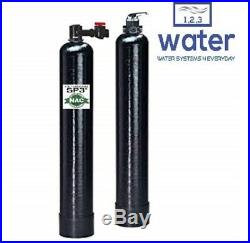

SALT FREE WATER SCALESTOP CONDITIONER 15 GPM & CATALYTIC CARBON 1 CU FT FILTER SYSTEM (DUAL TANK). A – SCALESTOP WATER CONDITIONER 15 GPM UPFLOW VALVE. B – 1 CU FT CATALYTIC CARBON FILTER MANUAL BACKWASH VALVE WHOLE HOUSE SYSTEM. A: Scale Prevention System (New Technology). NO lime scale build-up on pipes, fixtures or appliances and can even remove existing scale in some cases! Easy Installation, Two Connections, Simple pipe in /pipe out! Saves water no backwash required simple flow through to point of use! NO power required NO timer or backwash cycle! NO chemicals or salt required! Will not harm the environment; adds or removes nothing from the water while giving the benefits of soft water! The essential calcium and magnesium nutrients removed by traditional water softeners remain and there is no sodium added as with traditional softeners to aggravate cardiovascular or other health problems. 50% less soap and detergents required and enjoy whiter whites and brighter colors without hard water stains! Fits in limited space one small tank no brine tanks or large regeneration tanks! Calcium ions, magnesium ions and bicarbonate ions in untreated water form scale on the inside walls of pipe, exterior of fixtures and on heating surfaces because crystallization is not taking effect efficiently between the ions due to their suspension between water molecules and the need to come together in the proper alignment to form crystals. Therefore they form as scale on the surfaces of the water system. The system is a simple physical water treatment known as TAC (Template Assisted Crystallization) Template=mold, guide or pattern. Assisted=Help or make easy. Crystallization=Form a definite shape. Inside the TAC treatment tank are porcelain beads with the atomic level pattern of the crystal etched on their surface allowing for the calcium, magnesium and bicarbonate ions to come together on the template to created millions of microscopic crystals of scale that rapidly form and are released from the bead immediately into the treated water, not forming on the contact surfaces of the water system and are carried downstream in suspension through the water system. The crystal formation on the microscopic crystals (seed crystals) created on the beads and released in the water stream are the lowest energy reaction possible between the ions therefore existing scale will be dissolved back into the water stream by reacting with and forming crystals. The seed crystals are constantly being formed on the beads and released as catalyst for crystal growth in the water steam. Crystallization is the process that the magnet process and electrical charging of water claim to achieve. But by independent testing the electrical and magnetic methods are a maximum of 60% effective at scale prevention leaving an unacceptable level of 40% scaling. The TAC method is tested at 99.9% efficient at scale prevention and removal. Water Chemistry & Limitations. PH 6.5 to 8.5. Hardness Max 75 Grains (1300 ppm CaCO3). Temperature 41 to 140 F (5-60 C). Iron 0.3 mg/l. Manganese 0.05 mg/l. Copper 1.3 mg/l. Oil & H2S Remove prior to Scalestop. Polyphosphates Remove prior to Scalestop. FILTERSORB SP3 -SCALESTOP MEDIA. MINERAL TANK (Color Varies) 948. ADAPTERS 1 Pipe Connection. Whole House 948 Catalytic Carbon Whole House Filter 1 cu ft. Manual Back Wash Valve. Carbon is a substance that has a long history of being used to absorb impurities and is perhaps the most powerful absorbent known to man. One pound of carbon contains a surface area of roughly 125 acres and can absorb literally thousands of different chemicals. Activated carbon which has a slight electro-positive charge added to it, making it even more attractive to chemicals and impurities. In general, basic activated carbon itself has some catalytic activity due to the presence of a small number of chemical functionalities present on the corners of its graphitic basal plane. To enhance the catalytic activity of carbon, the surface is modified by a chemical process in which the electronic structure of the carbon is altered in such a manner that the resulting carbon offers enhanced catalytic capability. As a result, the catalytic carbon produced by this method is not only rich in chemisorption, but also physisorption capacity. The catalytic activity of carbon may be measured by the rate at which a carbon decomposes hydrogen peroxide. In general, the peroxide number is represented in terms of the time, in minutes, required to decompose a fixed amount of peroxide. The peroxide number also can be represented in terms of capacity to decompose peroxide in a fixed time. It is important to measure how fast the peroxide decomposition occurs. For comparison purposes, 1 gram of regular coconut shell-based activated carbon powder (100×325 mesh) shows approximately 20% capacity to decompose peroxide (from 30,000 ppm influent concentration), compared to more than 95% by corresponding catalytic carbon under an identical contact time of 10 minutes. Furthermore, it can be seen in Table 1 that the peroxide decomposition capacity increases significantly as the carbon particle size is decreased. For comparing the chloramine reduction capacity of GAC, a column adsorption test method was used, wherein 10 grams of carbon were packed and an input of 3-ppm chloramine solution was passed through the column at a constant flow rate of 50 cu cm per minute. Breakthrough for standard GAC was observed within 10 minutes, whereas the breakthrough for the catalytic carbon occured at 50 minutes. This increase in the chloramine reduction capacity is in line with the increase in the peroxide decomposition capacity from less than 5% to more than 50%. Powder activated carbon, both standard and catalytic, were used to make standard 10-in. Blocks for the comparison of chloramine reduction capacity. Like the column performance data, the performance of catalytic carbon block was superior to standard carbon block. The chloramine reduction capacity of the catalytic carbon block increased in proportion to the peroxide decomposition of the corresponding carbon. Benefits and Importance of a Upflow System. CATALYTIC CARBON 1 Cu Ft. MFV-1 Manual Back Wash Valve 1 Pipe Connection. MINERAL TANK (Tank color varies) 948. Ships only within US 48 Mainland street address. The item “WATER FILTER SALT FREE SCALE STOP CONDITIONER 15 GPM & CATALYTIC CARBON 1 CU FT” is in sale since Tuesday, November 8, 2016. This item is in the category “Home & Garden\Kitchen, Dining & Bar\Small Kitchen Appliances\Water Purification\Water Filters”. The seller is “123waterfilter” and is located in Lancaster, California. This item can be shipped to United States, United Kingdom, Denmark, Romania, Slovakia, Bulgaria, Czech republic, Finland, Hungary, Latvia, Lithuania, Malta, Estonia, Australia, Greece, Portugal, Cyprus, Slovenia, Japan, China, Sweden, South Korea, Indonesia, Taiwan, Thailand, Belgium, France, Hong Kong, Ireland, Netherlands, Poland, Spain, Italy, Germany, Austria, Bahamas, Israel, Mexico, New Zealand, Singapore, Switzerland, Norway, Saudi arabia, United arab emirates, Qatar, Kuwait, Bahrain, Croatia, Malaysia, Brazil, Chile, Costa rica, Panama, Trinidad and tobago, Guatemala, Honduras, Jamaica, Bangladesh, Brunei darussalam, Bolivia, Ecuador, Egypt, French guiana, Guernsey, Gibraltar, Guadeloupe, Iceland, Jersey, Jordan, Cambodia, Liechtenstein, Luxembourg, Monaco, Macao, Martinique, Nicaragua, Peru, Pakistan, Paraguay, Viet nam, Uruguay, Canada, South africa, Colombia, Barbados, Bermuda, Cayman islands, Maldives, Oman, Reunion, Sri lanka.
- Model: SF15G
- Country/Region of Manufacture: United States
- Filtration Method: Carbon/Charcoal
- Number of Filtrations: 2
- Type: Whole House Filter System
- Color: Multi-Color
- MPN: SF15G
- Brand: TWP


WHOLE HOUSE WATER FILTER SYSTEM Catalytic Carbon 1252 Backwash valve
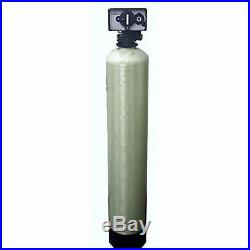

WHOLE HOUSE WATER FILTRATION SYSTEM. WHOLE HOUSE WATER FILTER SYSTEM Catalytic Carbon 1252 TANK WITH Backwash valve. Catalytic Carbon Backwashing Filter System. Are highly popular because they correct a wide range of water quality problems, by reducing chloramines, hydrogen sulfide, and tastes, odors, chlorine & sediment. 12 x 40 catalytic carbon. Great tasting water from every tap in your house. No bad tastes or foul odors. Crystal clear water for drinking, bathing, and cooking. Low maintenance due to automatic operation. This system uses 12×40 mesh catalytic, high activity granular activated carbon manufactured by steam activation of select coconut shell charcoal. The catalytic activity of this activated carbon makes it highly effective for the reduction of chloramines and hydrogen sulfide from potable water. Its large micropore volume makes it particularly well suited for the reduction of low molecular weight organic compounds and their chlorinated by-products such as chloroform and other trihalomethanes, THM’s. Catalytic Carbon Backwashing Filter System Specifications. Coconut Shell Catalytic Carbon Media (included) 2 CUBIC FT OF CARBON. BACKWASH VALVE AUTOMATIC TIMER. Personal checks may be held until cleared. Uncompromising Quality Water Systems. We have years of experience crafting our solutions for specific water sources in California. Our whole house water systems is designed to give you the best water quality from every faucet in your home. Setting ourselves apart from the competition, we use a three stage water system to clean, soften, and purify your water. A whole house filter, softener, and a reverse osmosis system. The item “WHOLE HOUSE WATER FILTER SYSTEM Catalytic Carbon 1252 Backwash valve” is in sale since Saturday, March 4, 2017. This item is in the category “Home & Garden\Home Improvement\Plumbing & Fixtures\Water Filters & Filtration Parts”. The seller is “waterworldsystem” and is located in Glendale, California. This item can be shipped worldwide.
- Brand: WATERWORLD
- Model: 1252BWCC
- MPN: Does Not Apply
- Type: WATER FILTER
- Country of Manufacture: United States
- hydrogen sulfide reduction filter: Sediment reduction filter


Whole House Anti-Scale Water Softener 20 GPM +Catalytic Carbon Filtration System
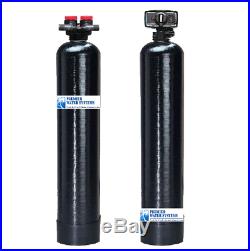
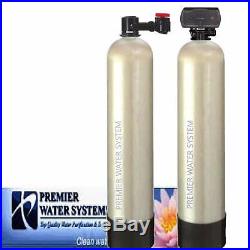
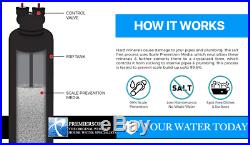
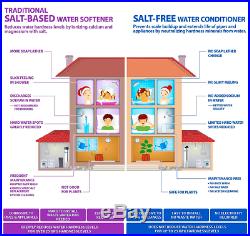

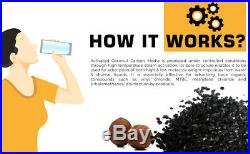
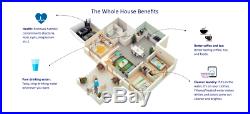
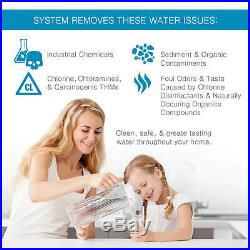
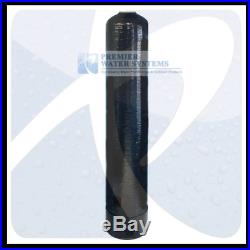

PremierSoft Whole House Anti-Scale, Salt-Free Water Softener/ Conditioner 20 GPM PLUS Backwash Whole House Carbon Water Filtration- 2 Complete Systems PREMIERWATERSYSTEMS. ACTUAL SYSTEM MAY APPEAR DIFFERENT THAN IMAGED PLEASE READ DESCRIPTION. Whole House NO-Salt Water Conditioning – 20 GPM. + Whole House Carbon Filter. 10″x 54″ 1.5 Cu Ft. 10″x54″ Mineral Tank (Almond, Black or Blue). Activated Coconut Shell Catalytic Carbon Media 1.5 cu ft. Scale Prevention System (New Technology). NO lime scale build-up on pipes, fixtures or appliances and can even remove existing scale in some cases! Easy Installation, Two Connections, Simple pipe in /pipe out! Saves water no backwash required simple flow through to point of use! NO power required NO timer or backwash cycle! NO chemicals or salt required! Will not harm the environment; adds or removes nothing from the water while giving the benefits of soft water! The essential calcium and magnesium nutrients removed by traditional water softeners remain and there is no sodium added as with traditional softeners to aggravate cardiovascular or other health problems. 50% less soap and detergents required and enjoy whiter whites and brighter colors without hard water stains! Fits in limited space one small tank no brine tanks or large regeneration tanks! Calcium ions, magnesium ions and bicarbonate ions in untreated water form scale on the inside walls of pipe, exterior of fixtures and on heating surfaces because crystallization is not taking effect efficiently between the ions due to their suspension between water molecules and the need to come together in the proper alignment to form crystals. Therefore they form as scale on the surfaces of the water system. The system is a simple physical water treatment known as TAC (Template Assisted Crystallization) Template=mold, guide or pattern. Assisted=Help or make easy. Crystallization form a definite shape. Inside the TAC treatment tank are porcelain beads with the atomic level pattern of the crystal etched on their surface allowing for the calcium, magnesium and bicarbonate ions to come together on the template to created millions of microscopic crystals of scale that rapidly form and are released from the bead immediately into the treated water, not forming on the contact surfaces of the water system and are carried downstream in suspension through the water system. The crystal formation on the microscopic crystals (seed crystals) created on the beads and released in the water stream are the lowest energy reaction possible between the ions therefore existing scale will be dissolved back into the water stream by reacting with and forming crystals. The seed crystals are constantly being formed on the beads and released as catalyst for crystal growth in the water steam. Crystallization is the process that the magnet process and electrical charging of water claim to achieve. But by independent testing the electrical and magnetic methods are a maximum of 60% effective at scale prevention leaving an unacceptable level of 40% scaling. The TAC method is tested at 99.9% efficient at scale prevention and removal. It is very important to protect your investment in a Salt Free System with a carbon filter if you have chlorinated water. Chlorine will greatly shorten the life cycle of the SCALE REDUCTION media. 10X54 Whole House Carbon Filter. 1.5 Cu Ft. Carbon is a substance that has a long history of Being used to absorb impurities and is perhaps the most powerful absorbent known to man. One pound of carbon contains a surface area of roughly 125 acres and can absorb literally thousands of different chemicals. Activated carbon which has a slight electro-positive charge added to it, making it even more attractive to chemicals and impurities. The two most important factors affecting the effici ency of activated carbon filtration are the amount of carbon in the unit and the amount of time the contaminant spends in contact with it. The more carbon the better. Similarly, the lower the flow rate of the water, the more time contaminants will be in contact with the carbon, and the more absorption that will take place. Particle size also affects removal rates. The most common carbon types used in water filtration are bituminous, wood, and coconut shell carbons. While coconut shell carbon typically costs 20% more than the others, it is generally regarded as the most effective of the three. All of our activated carbon filters use coconut shell carbon. Benefits and Importance of a Backwash Cycle. As the filter operates in service mode, it collects particles in the filter bed. Also, since water’s nature is to follow the path of least resistance, after a time it begins to cut channels through the medium. As channels or holes in the media bed form, water begins to flow around rather than through the medium. This process is called “channeling” and it reduces the effectiveness of the filter considerably. The backwash is accomplished by sending the water down the riser tube from which it enters the filter tank at the bottom. The force of the water is such that it actually lifts the media bed, swirling and tossing the granular medium. The water leaves the filter tank through the control valve, which routes it through the filter’s drain line. Particles that were in the bed are washed to drain. The backwash is an intense rinsing and tossing of the medium that lasts for several minutes. In a standard residential filter, a typical backwash lasts about ten minutes. After the backwash, the controls initiate a “rinse” of the bed during which water flows downward through the medium, up through the distribution tube aqnd out the drain. The purpose of this rinse is to rinse and settle the bed and prepare it for return to service flow. A regular backwash cycle prolongs the efficiency of the filter as well as provides cleaner water for your home. The AQUATROL 56FT TIMER control valve is the trusted standard in the industry. It can be programmed to automatically cycle through the backwash process. Please feel free to send us a message if you have any questions, or would like to customize this or any other system we have to fit your needs! Please visit our store for more systems, replacement filters, and parts for your system. PREMIER WATER SYSTEMS NORTH HOLLYWOOD, CALIFORNIA 661 575 0033. Track Page Views With. Auctiva’s FREE Counter. The item “Whole House Anti-Scale Water Softener 20 GPM +Catalytic Carbon Filtration System” is in sale since Friday, May 10, 2019. This item is in the category “Home & Garden\Home Improvement\Plumbing & Fixtures\Water Filtration Systems”. The seller is “dhillonnoni” and is located in North Hollywood, California. This item can be shipped to United States, Canada, United Kingdom, Denmark, Romania, Slovakia, Bulgaria, Czech republic, Finland, Hungary, Latvia, Lithuania, Malta, Estonia, Australia, Greece, Portugal, Cyprus, Slovenia, Japan, China, Sweden, South Korea, Indonesia, Taiwan, South africa, Thailand, Belgium, France, Hong Kong, Ireland, Netherlands, Poland, Spain, Italy, Germany, Austria, Bahamas, Israel, Mexico, New Zealand, Singapore, Switzerland, Norway, Saudi arabia, Ukraine, United arab emirates, Qatar, Kuwait, Bahrain, Croatia, Malaysia, Brazil, Chile, Colombia, Panama, Jamaica, Barbados, Bangladesh, Bermuda, Brunei darussalam, Bolivia, Ecuador, Egypt, French guiana, Guernsey, Gibraltar, Guadeloupe, Iceland, Jersey, Jordan, Cambodia, Cayman islands, Liechtenstein, Sri lanka, Luxembourg, Monaco, Macao, Martinique, Maldives, Nicaragua, Oman, Peru, Pakistan, Paraguay, Reunion, Viet nam, Uruguay.
- Featured Refinements: Water Softener
- Model: WHSP20WHCC2FT56FT
- Country/Region of Manufacture: United States
- Filter Type: Water Softeners
- Type: Whole House Water Filters
- MPN: WHSP20WHCC2FT56FT
- Brand: Premier Water Systems

POE Whole House Water Filter 1 CU FT Catalytic Carbon With In & out Valve 948


Whole House Water Filter System Catalytic Carbon (IN & OUT) No Electricity Required. In/Out tank-style water filters works great. Tank-style non-back washing filters are inexpensive, easy to set up, and easy to maintain. They use no electricity and need no drain connection. Since there’s nothing to wear out, they’re virtually trouble free. They use exactly the same granular filter media regular granular activated carbon that are used in our more expensive whole house back washing filters. The main requirement for use of these whole house non-back washing tank-style filters is clean water. If the objective is to remove chlorine from clean city water, a non-back washing In/Out filter does an exceptional job. Unless the inlet water is very clean and free of rust and other sediment, we recommend that a cartridge-style sediment filter be installed in front of the filter tank. The In/Out whole house carbon filters are efficient devices. They cost considerably less than their back washing counterparts and require less maintenance. They save water no back washing and they do not require electricity. With In/Out units, water simply enters the tank, passes through the media bed, and flows out. There is no cleaning process. Tank filters are arranged so that the water being treated flows upward through the tank, entering at the bottom and exiting at the top. This reversed flow lifts the bed, keeps it fresh, and minimizes channeling. The filters listed below are equipped with In/Out head offered. Estimated re-bed interval is every three years or so, depending on usage and chlorine content of your water. WHOLE HOUSE WATER FILTER. Whole-House Filter or Point of Entry. A whole-house filter is installed at a point on the homes water supply plumbing that will result in treatment of all water that travels to any faucet or fixture in the home. A whole-house filter system treats all water traveling to any faucet or fixture in the home. It removes the chemical before it can be ingested, breathed in, or absorbed by the skin during washing or bathing. Catalytic Carbon high activity granular activated carbon manufactured by steam activation of select coconut shell charcoal. The Catalytic activity of this activated carbon makes it highly effective for the removal of chloramines from potable water. Its large micropore volume makes it particularly well suited for the removal low molecular weight organic compounds and their chlorinate by-products such as chloroform and other trihalomethanes (THMs). An important feature of this material is its superior mechanical hardness and extensive dedusting during its manufacture ensures an exceptionally clean activated carbon product. Residential and Commercial Water Filters. Catalyst:One of the key characteristics of activated carbon is not only the high surface area available relative to their mass, but also the ability to act as a substrate for other materials. Activated carbons Carbons are carefully engineered to have the correct physical properties to optimize their use in this duty, manufactured from coconut shell, coal or wood bases. Many water utilities across the U. Are transitioning to chloramine for disinfection as an alternative to chlorine. This change is in response to stricter U. Environmental Protection Agency regulations on disinfection byproducts (DBPs), which are created when chlorine reacts with organics in water. Chloramine, a combination of chlorine and ammonia, is more stable and does not create DPBs. Removing chloramine at the point of use, however, is more difficult than removing chlorine. Standard granular activated carbon (GAC) and carbon gac products have limited capacity for chloramine reduction. Products known as catalytic or surface-modified activated carbon can provide a solution. In general, the catalytic properties of carbon are measured by the rate at which carbon decomposes hydrogen peroxide. The resulting peroxide number, measured in minutes, estimates the carbons utility in any catalytic application, including chloramine reduction. Based on the comparative results obtained for different mesh size commercial carbons, the efficiency of chloramine reduction is discussed in the terms of peroxide decomposition capacity and further extended to the total life (volume) claims for corresponding GAC carbon. Chemistry of Iron Oxidation. A mineral found in soil, iron normally exists in an insoluble oxide form, namely ferric oxide. If acidic or carbon dioxide containing water passes through the soil, the insoluble ferric oxide is reduced to the very soluble ferrous form. When water is pumped from the ground, oxygen from air enters the water and is available for reaction with the ferrous iron. In the presence of oxygen the ferrous form is eventually oxidized to the insoluble ferric form, resulting in familiar red deposits that stain sinks and clothes. In iron removal processes, the insoluble ferric hydroxide comes out of solution and is separated from the water by either filtration or settling. Catalytic carbon accelerates the reaction rate of ferrous to ferric iron dramatically, completely removing the in the relatively short time the water is in contact with the carbon. Under normal conditions, the reaction rate of ferrous to ferric iron is fairly slow, even when excess oxygen is present. This slow reaction rate necessitates the use of large retention tank and sedimentation tanks to allow time for precipitation to occur. A separate filtration step is then required to remove the remaining particulate. In treating iron-laden water, the catalytic properties of the form of granular activated carbon perform quite differently from standard activated carbon. The catalytic properties greatly accelerates the reaction time of iron to an insoluble form. By oxidizing iron from a soluble to less soluble state, catalytic carbon serves to simplify the removal. The resultant increase in reaction rate that occurs by using catalytic carbon allows smaller pieces of equipment to be used. As with all oxidation techniques, oxygen is required but a simple eductor or air injection pump is all that is required. As the reaction occurs, the precipitate is collected on the surface of the carbon, and a secondary filter is not required. Periodic backwashing is performed to remove this iron floc and return the carbon to a usable state. Another benefit of the catalytic carbon is its proven performance in removing hydrogen sulfide (H2S) from water. Many iron-containing waters also contain H2S and same bed of catalytic carbon can be used to remove both. Similarly, the unique reactive nature of the internal surface of activated carbon means that there is an inherent ability for the promotion of reactions between gases and liquids that would either proceed too slowly or generate uneconomic yields of final product. This is achieved without the need for the addition of a chemical reagent to the activated carbon and often true catalysis proceeds, without degradation of the surface or adsorbent. Whole House Water Filtration. This unit includes the following. 9″x 48″ FRP Mineral Tank (Color Varies). In & Out Valve. Good Economical Whole House Catalytic Carbon Water Filter System. Used or installed items are not accepte for return. Titan Water Pro is your “Clean Water Solutions”. The item “POE Whole House Water Filter 1 CU FT Catalytic Carbon With In & out Valve 948″ is in sale since Tuesday, October 15, 2019. This item is in the category “Home & Garden\Kitchen, Dining & Bar\Small Kitchen Appliances\Water Purification\Water Filters”. The seller is “titanwaterpro” and is located in Lancaster, California. This item can be shipped to United States, Canada, United Kingdom, Denmark, Romania, Slovakia, Bulgaria, Czech republic, Finland, Hungary, Latvia, Lithuania, Malta, Estonia, Australia, Greece, Portugal, Cyprus, Slovenia, Japan, China, Sweden, South Korea, Indonesia, Taiwan, South africa, Thailand, Belgium, France, Hong Kong, Ireland, Netherlands, Poland, Spain, Italy, Germany, Austria, Bahamas, Israel, Mexico, New Zealand, Philippines, Singapore, Switzerland, Norway, Saudi arabia, Ukraine, United arab emirates, Qatar, Kuwait, Bahrain, Croatia, Malaysia, Brazil, Chile, Colombia, Costa rica, Panama, Trinidad and tobago, Guatemala, Honduras, Jamaica, Antigua and barbuda, Aruba, Belize, Dominica, Grenada, Saint kitts and nevis, Saint lucia, Turks and caicos islands, Barbados, Bangladesh, Bermuda, Brunei darussalam, Bolivia, Egypt, French guiana, Gibraltar, Guadeloupe, Iceland, Jordan, Cambodia, Cayman islands, Sri lanka, Luxembourg, Maldives, Nicaragua, Oman, Peru, Pakistan, Paraguay, Viet nam, Uruguay.
- Filtration Method: Carbon/Charcoal
- water filter: water filters
- granular activated carbon: in and out valve
- Brand: Titan Water Pro
- Custom Bundle: No
- frp mineral tank: coconut shell carbon
- Model: TW1CF
- Number of Filtrations: 1
- Type: Water Filter
- whole house water filter: gac coconut shell catalytic carbon
- MPN: TWP188WH
- Color: Multicolor

POE Whole House Water Filter 2 CU FT Catalytic Carbon With In & out Valve 1252


Whole House Water Filter System Catalytic Carbon (IN & OUT) No Electricity Required. In/Out tank-style water filters works great. Tank-style non-back washing filters are inexpensive, easy to set up, and easy to maintain. They use no electricity and need no drain connection. Since there’s nothing to wear out, they’re virtually trouble free. They use exactly the same granular filter media regular granular activated carbon that are used in our more expensive whole house back washing filters. The main requirement for use of these whole house non-back washing tank-style filters is clean water. If the objective is to remove chlorine from clean city water, a non-back washing In/Out filter does an exceptional job. Unless the inlet water is very clean and free of rust and other sediment, we recommend that a cartridge-style sediment filter be installed in front of the filter tank. The In/Out whole house carbon filters are efficient devices. They cost considerably less than their back washing counterparts and require less maintenance. They save water no back washing and they do not require electricity. With In/Out units, water simply enters the tank, passes through the media bed, and flows out. There is no cleaning process. Tank filters are arranged so that the water being treated flows upward through the tank, entering at the bottom and exiting at the top. This reversed flow lifts the bed, keeps it fresh, and minimizes channeling. The filters listed below are equipped with In/Out head offered. Estimated re-bed interval is every three years or so, depending on usage and chlorine content of your water. WHOLE HOUSE WATER FILTER. Whole-House Filter or Point of Entry. A whole-house filter is installed at a point on the homes water supply plumbing that will result in treatment of all water that travels to any faucet or fixture in the home. A whole-house filter system treats all water traveling to any faucet or fixture in the home. It removes the chemical before it can be ingested, breathed in, or absorbed by the skin during washing or bathing. Catalytic Carbon high activity granular activated carbon manufactured by steam activation of select coconut shell charcoal. The Catalytic activity of this activated carbon makes it highly effective for the removal of chloramines from potable water. Its large micropore volume makes it particularly well suited for the removal low molecular weight organic compounds and their chlorinate by-products such as chloroform and other trihalomethanes (THMs). An important feature of this material is its superior mechanical hardness and extensive dedusting during its manufacture ensures an exceptionally clean activated carbon product. Residential and Commercial Water Filters. One of the key characteristics of activated carbon is not only the high surface area available relative to their mass, but also the ability to act as a substrate for other materials. Activated carbons Carbons are carefully engineered to have the correct physical properties to optimize their use in this duty, manufactured from coconut shell, coal or wood bases. Many water utilities across the U. Are transitioning to chloramine for disinfection as an alternative to chlorine. This change is in response to stricter U. Environmental Protection Agency regulations on disinfection byproducts (DBPs), which are created when chlorine reacts with organics in water. Chloramine, a combination of chlorine and ammonia, is more stable and does not create DPBs. Removing chloramine at the point of use, however, is more difficult than removing chlorine. Standard granular activated carbon (GAC) and carbon gac products have limited capacity for chloramine reduction. Products known as catalytic or surface-modified activated carbon can provide a solution. In general, the catalytic properties of carbon are measured by the rate at which carbon decomposes hydrogen peroxide. The resulting peroxide number, measured in minutes, estimates the carbons utility in any catalytic application, including chloramine reduction. Based on the comparative results obtained for different mesh size commercial carbons, the efficiency of chloramine reduction is discussed in the terms of peroxide decomposition capacity and further extended to the total life (volume) claims for corresponding GAC carbon. Chemistry of Iron Oxidation. A mineral found in soil, iron normally exists in an insoluble oxide form, namely ferric oxide. If acidic or carbon dioxide containing water passes through the soil, the insoluble ferric oxide is reduced to the very soluble ferrous form. When water is pumped from the ground, oxygen from air enters the water and is available for reaction with the ferrous iron. In the presence of oxygen the ferrous form is eventually oxidized to the insoluble ferric form, resulting in familiar red deposits that stain sinks and clothes. In iron removal processes, the insoluble ferric hydroxide comes out of solution and is separated from the water by either filtration or settling. Catalytic carbon accelerates the reaction rate of ferrous to ferric iron dramatically, completely removing the in the relatively short time the water is in contact with the carbon. Under normal conditions, the reaction rate of ferrous to ferric iron is fairly slow, even when excess oxygen is present. This slow reaction rate necessitates the use of large retention tank and sedimentation tanks to allow time for precipitation to occur. A separate filtration step is then required to remove the remaining particulate. In treating iron-laden water, the catalytic properties of the form of granular activated carbon perform quite differently from standard activated carbon. The catalytic properties greatly accelerates the reaction time of iron to an insoluble form. By oxidizing iron from a soluble to less soluble state, catalytic carbon serves to simplify the removal. The resultant increase in reaction rate that occurs by using catalytic carbon allows smaller pieces of equipment to be used. As with all oxidation techniques, oxygen is required but a simple eductor or air injection pump is all that is required. As the reaction occurs, the precipitate is collected on the surface of the carbon, and a secondary filter is not required. Periodic backwashing is performed to remove this iron floc and return the carbon to a usable state. Another benefit of the catalytic carbon is its proven performance in removing hydrogen sulfide (H2S) from water. Many iron-containing waters also contain H2S and same bed of catalytic carbon can be used to remove both. Similarly, the unique reactive nature of the internal surface of activated carbon means that there is an inherent ability for the promotion of reactions between gases and liquids that would either proceed too slowly or generate uneconomic yields of final product. This is achieved without the need for the addition of a chemical reagent to the activated carbon and often true catalysis proceeds, without degradation of the surface or adsorbent. Whole House Water Filtration. This unit includes the following. 12″x 52″ FRP Mineral Tank (Color Varies). In & Out Valve. 2 CU FT Catalytic Carbon. Good Economical Whole House Catalytic Carbon Water Filter System. Used or installed items are not accepte for return. Titan Water Pro is your “Clean Water Solutions”. Track Page Views With. Auctiva’s FREE Counter. The item “POE Whole House Water Filter 2 CU FT Catalytic Carbon With In & out Valve 1252″ is in sale since Friday, October 18, 2019. This item is in the category “Home & Garden\Kitchen, Dining & Bar\Small Kitchen Appliances\Water Purification\Water Filters”. The seller is “titanwaterpro” and is located in Lancaster, California. This item can be shipped to United States, Canada, United Kingdom, Denmark, Romania, Slovakia, Bulgaria, Czech republic, Finland, Hungary, Latvia, Lithuania, Malta, Estonia, Australia, Greece, Portugal, Cyprus, Slovenia, Japan, China, Sweden, South Korea, Indonesia, Taiwan, South africa, Thailand, Belgium, France, Hong Kong, Ireland, Netherlands, Poland, Spain, Italy, Germany, Austria, Bahamas, Israel, Mexico, New Zealand, Philippines, Singapore, Switzerland, Norway, Saudi arabia, Ukraine, United arab emirates, Qatar, Kuwait, Bahrain, Croatia, Malaysia, Brazil, Chile, Colombia, Costa rica, Panama, Trinidad and tobago, Guatemala, Honduras, Jamaica, Antigua and barbuda, Aruba, Belize, Dominica, Grenada, Saint kitts and nevis, Saint lucia, Turks and caicos islands, Barbados, Bangladesh, Bermuda, Brunei darussalam, Bolivia, Egypt, French guiana, Gibraltar, Guadeloupe, Iceland, Jordan, Cambodia, Cayman islands, Sri lanka, Luxembourg, Maldives, Nicaragua, Oman, Peru, Pakistan, Paraguay, Viet nam, Uruguay.
- Model: TW2CF
- Custom Bundle: No
- Filtration Method: Carbon/Charcoal
- granular activated carbon: in and out valve
- water filter: water filters
- whole house water filter: gac coconut shell catalytic carbon
- frp mineral tank: CALTYTIC coconut shell carbon
- Type: Water Filter
- Number of Filtrations: 1
- Color: Multicolor
- MPN: TWP1252CATIO
- Brand: Titan Water Pro
- Suitable For: Commercial

POE Whole House Water Filter 1.5 CU FT Catalytic Carbon With In & out Valve 1054


Whole House Water Filter System Catalytic Carbon (IN & OUT) No Electricity Required. In/Out tank-style water filters works great. Tank-style non-back washing filters are inexpensive, easy to set up, and easy to maintain. They use no electricity and need no drain connection. Since there’s nothing to wear out, they’re virtually trouble free. They use exactly the same granular filter media regular granular activated carbon that are used in our more expensive whole house back washing filters. The main requirement for use of these whole house non-back washing tank-style filters is clean water. If the objective is to remove chlorine from clean city water, a non-back washing In/Out filter does an exceptional job. Unless the inlet water is very clean and free of rust and other sediment, we recommend that a cartridge-style sediment filter be installed in front of the filter tank. The In/Out whole house carbon filters are efficient devices. They cost considerably less than their back washing counterparts and require less maintenance. They save water no back washing and they do not require electricity. With In/Out units, water simply enters the tank, passes through the media bed, and flows out. There is no cleaning process. Tank filters are arranged so that the water being treated flows upward through the tank, entering at the bottom and exiting at the top. This reversed flow lifts the bed, keeps it fresh, and minimizes channeling. The filters listed below are equipped with In/Out head offered. Estimated re-bed interval is every three years or so, depending on usage and chlorine content of your water. WHOLE HOUSE WATER FILTER. Whole-House Filter or Point of Entry. A whole-house filter is installed at a point on the homes water supply plumbing that will result in treatment of all water that travels to any faucet or fixture in the home. A whole-house filter system treats all water traveling to any faucet or fixture in the home. It removes the chemical before it can be ingested, breathed in, or absorbed by the skin during washing or bathing. Catalytic Carbon high activity granular activated carbon manufactured by steam activation of select coconut shell charcoal. The Catalytic activity of this activated carbon makes it highly effective for the removal of chloramines from potable water. Its large micropore volume makes it particularly well suited for the removal low molecular weight organic compounds and their chlorinate by-products such as chloroform and other trihalomethanes (THMs). An important feature of this material is its superior mechanical hardness and extensive dedusting during its manufacture ensures an exceptionally clean activated carbon product. Residential and Commercial Water Filters. One of the key characteristics of activated carbon is not only the high surface area available relative to their mass, but also the ability to act as a substrate for other materials. Activated carbons Carbons are carefully engineered to have the correct physical properties to optimize their use in this duty, manufactured from coconut shell, coal or wood bases. Many water utilities across the U. Are transitioning to chloramine for disinfection as an alternative to chlorine. This change is in response to stricter U. Environmental Protection Agency regulations on disinfection byproducts (DBPs), which are created when chlorine reacts with organics in water. Chloramine, a combination of chlorine and ammonia, is more stable and does not create DPBs. Removing chloramine at the point of use, however, is more difficult than removing chlorine. Standard granular activated carbon (GAC) and carbon gac products have limited capacity for chloramine reduction. Products known as catalytic or surface-modified activated carbon can provide a solution. In general, the catalytic properties of carbon are measured by the rate at which carbon decomposes hydrogen peroxide. The resulting peroxide number, measured in minutes, estimates the carbons utility in any catalytic application, including chloramine reduction. Based on the comparative results obtained for different mesh size commercial carbons, the efficiency of chloramine reduction is discussed in the terms of peroxide decomposition capacity and further extended to the total life (volume) claims for corresponding GAC carbon. Chemistry of Iron Oxidation. A mineral found in soil, iron normally exists in an insoluble oxide form, namely ferric oxide. If acidic or carbon dioxide containing water passes through the soil, the insoluble ferric oxide is reduced to the very soluble ferrous form. When water is pumped from the ground, oxygen from air enters the water and is available for reaction with the ferrous iron. In the presence of oxygen the ferrous form is eventually oxidized to the insoluble ferric form, resulting in familiar red deposits that stain sinks and clothes. In iron removal processes, the insoluble ferric hydroxide comes out of solution and is separated from the water by either filtration or settling. Catalytic carbon accelerates the reaction rate of ferrous to ferric iron dramatically, completely removing the in the relatively short time the water is in contact with the carbon. Under normal conditions, the reaction rate of ferrous to ferric iron is fairly slow, even when excess oxygen is present. This slow reaction rate necessitates the use of large retention tank and sedimentation tanks to allow time for precipitation to occur. A separate filtration step is then required to remove the remaining particulate. In treating iron-laden water, the catalytic properties of the form of granular activated carbon perform quite differently from standard activated carbon. The catalytic properties greatly accelerates the reaction time of iron to an insoluble form. By oxidizing iron from a soluble to less soluble state, catalytic carbon serves to simplify the removal. The resultant increase in reaction rate that occurs by using catalytic carbon allows smaller pieces of equipment to be used. As with all oxidation techniques, oxygen is required but a simple eductor or air injection pump is all that is required. As the reaction occurs, the precipitate is collected on the surface of the carbon, and a secondary filter is not required. Periodic backwashing is performed to remove this iron floc and return the carbon to a usable state. Another benefit of the catalytic carbon is its proven performance in removing hydrogen sulfide (H2S) from water. Many iron-containing waters also contain H2S and same bed of catalytic carbon can be used to remove both. Similarly, the unique reactive nature of the internal surface of activated carbon means that there is an inherent ability for the promotion of reactions between gases and liquids that would either proceed too slowly or generate uneconomic yields of final product. This is achieved without the need for the addition of a chemical reagent to the activated carbon and often true catalysis proceeds, without degradation of the surface or adsorbent. Whole House Water Filtration. This unit includes the following. 10″x 54″ FRP Mineral Tank (Color Varies). In & Out Valve. 1.5 CU FT Catalytic Carbon. Good Economical Whole House Catalytic Carbon Water Filter System. Used or installed items are not accepte for return. Titan Water Pro is your “Clean Water Solutions”. Track Page Views With. Auctiva’s FREE Counter. The item “POE Whole House Water Filter 1.5 CU FT Catalytic Carbon With In & out Valve 1054″ is in sale since Friday, October 18, 2019. This item is in the category “Home & Garden\Kitchen, Dining & Bar\Small Kitchen Appliances\Water Purification\Water Filters”. The seller is “titanwaterpro” and is located in Lancaster, California. This item can be shipped to United States, Canada, United Kingdom, Denmark, Romania, Slovakia, Bulgaria, Czech republic, Finland, Hungary, Latvia, Lithuania, Malta, Estonia, Australia, Greece, Portugal, Cyprus, Slovenia, Japan, China, Sweden, South Korea, Indonesia, Taiwan, South africa, Thailand, Belgium, France, Hong Kong, Ireland, Netherlands, Poland, Spain, Italy, Germany, Austria, Bahamas, Israel, Mexico, New Zealand, Philippines, Singapore, Switzerland, Norway, Saudi arabia, Ukraine, United arab emirates, Qatar, Kuwait, Bahrain, Croatia, Malaysia, Brazil, Chile, Colombia, Costa rica, Panama, Trinidad and tobago, Guatemala, Honduras, Jamaica, Antigua and barbuda, Aruba, Belize, Dominica, Grenada, Saint kitts and nevis, Saint lucia, Turks and caicos islands, Barbados, Bangladesh, Bermuda, Brunei darussalam, Bolivia, Egypt, French guiana, Gibraltar, Guadeloupe, Iceland, Jordan, Cambodia, Cayman islands, Sri lanka, Luxembourg, Maldives, Nicaragua, Oman, Peru, Pakistan, Paraguay, Viet nam, Uruguay.
- Model: TW15CF
- Custom Bundle: No
- Filtration Method: Carbon/Charcoal
- granular activated carbon: in and out valve
- water filter: water filters
- whole house water filter: gac coconut shell catalytic carbon
- frp mineral tank: CALTYTIC coconut shell carbon
- Type: Water Filter
- Number of Filtrations: 1
- Color: Multicolor
- MPN: TWP1054CATIO
- Brand: Titan Water Pro
- Suitable For: Commercial


Whole House Fluoride/Chloramine Reduction/Removal Bone Char Catalytic Carbon 2CF
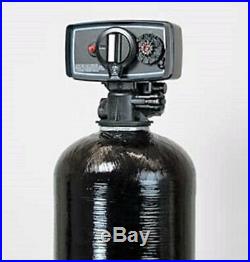
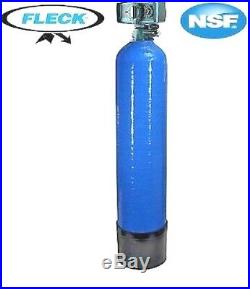
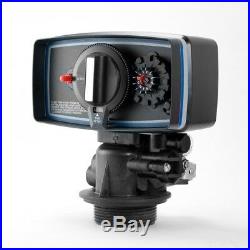

Whole House Fluoride, Chloramine, Chlorine, VOC’s, THM, H2S Plus water treatment 2 cu f. Fleck 5600 Filter Backwash Valve. Catalytic Carbon & Bone Char Blend. Whole House 2 Cubic Feet Blended Catalytic & Bone Char Carbon 1252 FRP Tank – Manual Backwash Valve. Unlike standard coconut or charcoal based carbon filters which cannot filter fluoride, our Whole House Filter uses a unique calcium based Bone Char carbon designed to reduce the fluoride from your water. Removes/Reduces Fluoride, and chemicals and odors. Additional Metals Addressed By Bone Char Carbon. The information provided on this table is based on Additional testing results of removal efficiency for heavy metals with the use of Bonechar courtesy of Glasgow University, UK and manufacturers of Bone Char. Additional contaminants that bone char carbon is recommended for are not certified by WQA or state standards. Contaminates addressed by bone char may not be in your water. The use of bone charcoal or bone char is reported to be an effective means for the reduction of fluoride. Bone charcoal contains a carbon structure while supporting a porous hydroxyapatite matrix (a calcium phosphate hydroxide in crystalline form which is rich in surface ions which can be readily replaced by fluoride ion). The carbon media also works like regular carbon does. A whole-house filter system treats all water traveling to any faucet or fixture in the home. It removes the chemical before it can be ingested, breathed in, or absorbed by the skin during washing or bathing. A larger carbon filter like this one provides better filtration because of the amount of carbon, and depth of the filter bed. It does not cause a water pressure drop in your home compared to solid block carbon filter installed at the point of entry. Carbon removes/reduces many volatile organic chemicals (VOC), pesticides and herbicides, as well as chlorine, benzene, trihalomethane (THM) compounds, radon, solvents and hundreds of other man-made chemicals found in tap water. Carbon is a substance that has a long history of being used to absorb impurities and is perhaps the most powerful absorbent known to man. One pound of carbon contains a surface area of roughly 125 acres and can absorb literally thousands of different chemicals. Activated carbon which has a slight electro-positive charge added to it, making it even more attractive to chemicals and impurities. Catalytic, high activity granular activated carbon manufactured by steam activation of select coconut shell charcoal. The catalytic activity of this activated carbon makes it highly effective for the removal of chloramines and hydrogen sulfide from potable water. Its large micropore volume makes it particularly well suited for the removal of low molecular weight organic compounds and their chlorinated by-products such as chloroform and other trihalomethanes (THMs). An important feature of this material is its superior mechanical hardness and the extensive dedusting during its manufacture ensures an exceptionally clean activated carbon product. 1 – 12X52 FRP vessel (Color Varies). 1 – Fleck 5600 Filter Backwash Valve. 2 – Cubic ft Blended Bone Char & Catalytic Carbon. 1 – Bypass Valve 1. Used or installed items are not accepted for return. Any damage or item/parts you think may be missing. Titan Water Pro is your “Clean Water Solutions”. The item “Whole House Fluoride/Chloramine Reduction/Removal Bone Char Catalytic Carbon 2CF” is in sale since Tuesday, October 16, 2018. This item is in the category “Home & Garden\Kitchen, Dining & Bar\Small Kitchen Appliances\Water Purification\Water Filters”. The seller is “titanwaterpro” and is located in Lancaster, California. This item can be shipped to United States, Canada, United Kingdom, Denmark, Romania, Slovakia, Bulgaria, Czech republic, Finland, Hungary, Latvia, Lithuania, Malta, Estonia, Australia, Greece, Portugal, Cyprus, Slovenia, Japan, China, Sweden, South Korea, Indonesia, Taiwan, South africa, Thailand, Belgium, France, Hong Kong, Ireland, Netherlands, Poland, Spain, Italy, Germany, Austria, Bahamas, Israel, Mexico, New Zealand, Singapore, Switzerland, Norway, Saudi arabia, Ukraine, United arab emirates, Qatar, Kuwait, Bahrain, Croatia, Malaysia, Brazil, Chile, Colombia, Costa rica, Panama, Trinidad and tobago, Guatemala, Honduras, Jamaica, Barbados, Bangladesh, Bermuda, Brunei darussalam, Bolivia, Egypt, French guiana, Gibraltar, Guadeloupe, Iceland, Jordan, Cambodia, Cayman islands, Sri lanka, Luxembourg, Maldives, Nicaragua, Oman, Peru, Pakistan, Paraguay, Viet nam, Uruguay.
- Filtration Method: Carbon/Charcoal
- bone char: bone char carbon
- FRP Vessel Tank: Manual Back Wash Valve
- catalytic carbon: chloramine removal
- fluoride removal: fluoride reduction
- Number of Filtrations: 2
- Type: Whole House Filter System
- MPN: TWPBCATBC
- Brand: Titan Water Pro


Whole-House Water Filter System Catalytic Carbon 2 CU FT Fleck 5600 SXT Digital
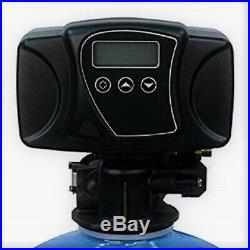

Whole House Water Filter System 2 CU FT Catalytic Carbon with Digitial Fleck 5600. WHOLE HOUSE WATER FILTER (Municipal & Well Water). Whole-House Filter or Point of Entry. A whole-house filter is installed at a point on the homes water supply plumbing that will result in treatment of all water that travels to any faucet or fixture in the home. A whole-house filter system treats all water traveling to any faucet or fixture in the home. It removes the chemical before it can be ingested, breathed in, or absorbed by the skin during washing or bathing. Catalytic Carbon high activity granular activated carbon manufactured by steam activation of select coconut shell charcoal. The Catalytic activity of this activated carbon makes it highly effective for the removal of chloramines from potable water. Its large micropore volume makes it particularly well suited for the removal low molecular weight organic compounds and their chlorinate by-products such as chloroform and other trihalomethanes (THMs). An important feature of this material is its superior mechanical hardness and extensive dedusting during its manufacture ensures an exceptionally clean activated carbon product. Residential and Commercial Water Filters. One of the key characteristics of activated carbon is not only the high surface area available relative to their mass, but also the ability to act as a substrate for other materials. Activated carbons are carefully engineered to have the correct physical properties to optimize their use in this duty, manufactured from coconut shell, coal or wood bases. Many water utilities across the U. Are transitioning to chloramine for disinfection as an alternative to chlorine. This change is in response to stricter U. Environmental Protection Agency regulations on disinfection byproducts (DBPs), which are created when chlorine reacts with organics in water. Chloramine, a combination of chlorine and ammonia, is more stable and does not create DPBs. Removing chloramine at the point of use, however, is more difficult than removing chlorine. Standard granular activated carbon (GAC) and carbon gac products have limited capacity for chloramine reduction. Products known as catalytic or surface-modified activated carbon can provide a solution. In general, the catalytic properties of carbon are measured by the rate at which carbon decomposes hydrogen peroxide. The resulting peroxide number, measured in minutes, estimates the carbons utility in any catalytic application, including chloramine reduction. Based on the comparative results obtained for different mesh size commercial carbons, the efficiency of chloramine reduction is discussed in the terms of peroxide decomposition capacity and further extended to the total life (volume) claims for corresponding GAC carbon. Chemistry of Iron Oxidation. A mineral found in soil, iron normally exists in an insoluble oxide form, namely ferric oxide. If acidic or carbon dioxide containing water passes through the soil, the insoluble ferric oxide is reduced to the very soluble ferrous form. When water is pumped from the ground, oxygen from air enters the water and is available for reaction with the ferrous iron. In the presence of oxygen the ferrous form is eventually oxidized to the insoluble ferric form, resulting in familiar red deposits that stain sinks and clothes. In iron removal processes, the insoluble ferric hydroxide comes out of solution and is separated from the water by either filtration or settling. Catalytic carbon accelerates the reaction rate of ferrous to ferric iron dramatically, completely removing the in the relatively short time the water is in contact with the carbon. Under normal conditions, the reaction rate of ferrous to ferric iron is fairly slow, even when excess oxygen is present. This slow reaction rate necessitates the use of large retention tank and sedimentation tanks to allow time for precipitation to occur. A separate filtration step is then required to remove the remaining particulate. In treating iron-laden water, the catalytic properties of the form of granular activated carbon perform quite differently from standard activated carbon. The catalytic properties greatly accelerates the reaction time of iron to an insoluble form. By oxidizing iron from a soluble to less soluble state, catalytic carbon serves to simplify the removal. The resultant increase in reaction rate that occurs by using catalytic carbon allows smaller pieces of equipment to be used. As with all oxidation techniques, oxygen is required but a simple eductor or air injection pump is all that is required. As the reaction occurs, the precipitate is collected on the surface of the carbon, and a secondary filter is not required. Periodic backwashing is performed to remove this iron floc and return the carbon to a usable state. Another benefit of the catalytic carbon is its proven performance in removing hydrogen sulfide (H2S) from water. Many iron-containing waters also contain H2S and same bed of catalytic carbon can be used to remove both. Similarly, the unique reactive nature of the internal surface of activated carbon means that there is an inherent ability for the promotion of reactions between gases and liquids that would either proceed too slowly or generate uneconomic yields of final product. This is achieved without the need for the addition of a chemical reagent to the activated carbon and often true catalysis proceeds, without degradation of the surface or adsorbent. Whole House Water Filtration. This unit includes the following. 1252 FRP Mineral Tank (Color Varies). Catalytic Carbon 2 Cu Ft. Fleck 5600SXT Digital Backwash Control Unit. Good Economical Whole House Catalytic Carbon Water Filter System. Hydrogen sulfide concentrations exceeding 7 to 10 ppm can be removed by injecting an oxidizing chemical such as household bleach followed up by filtration. The oxidizing chemical should enter the water upstream from the storage or mixing tank to provide at least 30-45 minutes of contact time between the chemical and water. The length of length of the holding time is a function of the chemical dosage, tank configuration and water temperature. Sulfur particles can then be removed using a sediment filter and the excess chlorine can be removed by activated carbon filtration. If test results indicate that bacterial contamination is occurring, shock chlorination or disinfection is the most widely suggested method for initial treatment. Shock chlorination (disinfection) is the one-time introduction of a strong solution into the entire water distribution system well, pump, distribution pipeline, etc. When to Shock Disinfect the Well. Shock chlorination (disinfection) is recommended when lab results indicate a presence of bacteria upon completion of a new well or after pump replacement or repair, when the distribution system is opened for repairs or maintenance, following contamination by flood water, to control iron and sulfur bacteria. Shock chlorination (disinfection) is recommended in these circumstances to ensure that bacterial contamination is controlled. This system should be used where low to moderate ferrous (dissolved) iron or hydrogen sulfide contamination is known. This filter is most effective where iron and hydrogen sulfide levels are less then 5 ppm. Best removal rates are achieved where pH is between 6.5 and 8.5 and where water contains some dissolved oxygen. Selecting a water treatment system begins with water test results from a certified drinking water testing lab. Such test results should be compared to the water treatment product specifications to ensure that the treatment system being considered is designed to treat. The substances you want to treat. In the concentrations at which they exist in your water. There is no one-size-fits-all water treatment technology that addresses all water quality problems. In some cases, one treatment technology may meet all your specific needs. In other cases, you may need a treatment traina series of treatment technologies in a sequence that treat one or more water quality problems. Again, when considering water treatment, use your lab test results as a guide and make sure the technology you are considering is designed to treat the problematic substances in your water. Used or Installed items are not eligible for return. Titan Water Pro is your “Clean Water Solutions”. The item “Whole-House Water Filter System Catalytic Carbon 2 CU FT Fleck 5600 SXT Digital” is in sale since Friday, November 29, 2019. This item is in the category “Home & Garden\Kitchen, Dining & Bar\Small Kitchen Appliances\Water Purification\Water Filters”. The seller is “titanwaterpro” and is located in Lancaster, California. This item can be shipped to United States, Canada, United Kingdom, Denmark, Romania, Slovakia, Bulgaria, Czech republic, Finland, Hungary, Latvia, Lithuania, Malta, Estonia, Australia, Greece, Portugal, Cyprus, Slovenia, Japan, China, Sweden, South Korea, Indonesia, Taiwan, South africa, Thailand, Belgium, France, Hong Kong, Ireland, Netherlands, Poland, Spain, Italy, Germany, Austria, Bahamas, Israel, Mexico, New Zealand, Singapore, Switzerland, Norway, Saudi arabia, Ukraine, United arab emirates, Qatar, Kuwait, Bahrain, Croatia, Malaysia, Brazil, Chile, Colombia, Costa rica, Panama, Trinidad and tobago, Guatemala, Honduras, Jamaica, Barbados, Bangladesh, Bermuda, Brunei darussalam, Bolivia, Egypt, French guiana, Gibraltar, Guadeloupe, Iceland, Jordan, Cambodia, Cayman islands, Sri lanka, Luxembourg, Maldives, Nicaragua, Oman, Peru, Pakistan, Paraguay, Viet nam, Uruguay.
- Model: WHCC1252T
- Filtration Method: Carbon/Charcoal
- Power: 110V
- water filter: POE Water Filter
- Iron Removal: H2S
- Chloramine Removal: Chlorine Removal
- Type: Water Filter
- catalytic carbon: frp tank
- Number of Filtrations: 1
- Color: Multi-Color
- MPN: TWP188WH
- Brand: Fleck
- Suitable For: Commercial

Whole-House Water Filter System Catalytic Carbon 2 CU FT AQT-56FT
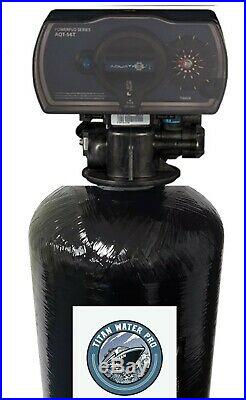

Whole House Water Filter System 2 CU FT Catalytic Carbon with Aquatrol FT56 Backwash Valve. WHOLE HOUSE WATER FILTER. Whole-House Filter or Point of Entry. A whole-house filter is installed at a point on the homes water supply plumbing that will result in treatment of all water that travels to any faucet or fixture in the home. A whole-house filter system treats all water traveling to any faucet or fixture in the home. It removes the chemical before it can be ingested, breathed in, or absorbed by the skin during washing or bathing. Catalytic Carbon high activity granular activated carbon manufactured by steam activation of select coconut shell charcoal. The Catalytic activity of this activated carbon makes it highly effective for the removal of chloramines from potable water. Its large micropore volume makes it particularly well suited for the removal low molecular weight organic compounds and their chlorinate by-products such as chloroform and other trihalomethanes (THMs). An important feature of this material is its superior mechanical hardness and extensive dedusting during its manufacture ensures an exceptionally clean activated carbon product. Residential and Commercial Water Filters. One of the key characteristics of activated carbon is not only the high surface area available relative to their mass, but also the ability to act as a substrate for other materials. Activated carbons are carefully engineered to have the correct physical properties to optimize their use in this duty, manufactured from coconut shell, coal or wood bases. Many water utilities across the U. Are transitioning to chloramine for disinfection as an alternative to chlorine. This change is in response to stricter U. Environmental Protection Agency regulations on disinfection byproducts (DBPs), which are created when chlorine reacts with organics in water. Chloramine, a combination of chlorine and ammonia, is more stable and does not create DPBs. Removing chloramine at the point of use, however, is more difficult than removing chlorine. Standard granular activated carbon (GAC) and carbon gac products have limited capacity for chloramine reduction. Products known as catalytic or surface-modified activated carbon can provide a solution. In general, the catalytic properties of carbon are measured by the rate at which carbon decomposes hydrogen peroxide. The resulting peroxide number, measured in minutes, estimates the carbons utility in any catalytic application, including chloramine reduction. Based on the comparative results obtained for different mesh size commercial carbons, the efficiency of chloramine reduction is discussed in the terms of peroxide decomposition capacity and further extended to the total life (volume) claims for corresponding GAC carbon. Chemistry of Iron Oxidation. A mineral found in soil, iron normally exists in an insoluble oxide form, namely ferric oxide. If acidic or carbon dioxide containing water passes through the soil, the insoluble ferric oxide is reduced to the very soluble ferrous form. When water is pumped from the ground, oxygen from air enters the water and is available for reaction with the ferrous iron. In the presence of oxygen the ferrous form is eventually oxidized to the insoluble ferric form, resulting in familiar red deposits that stain sinks and clothes. In iron removal processes, the insoluble ferric hydroxide comes out of solution and is separated from the water by either filtration or settling. Catalytic carbon accelerates the reaction rate of ferrous to ferric iron dramatically, completely removing the in the relatively short time the water is in contact with the carbon. Under normal conditions, the reaction rate of ferrous to ferric iron is fairly slow, even when excess oxygen is present. This slow reaction rate necessitates the use of large retention tank and sedimentation tanks to allow time for precipitation to occur. A separate filtration step is then required to remove the remaining particulate. In treating iron-laden water, the catalytic properties of the form of granular activated carbon perform quite differently from standard activated carbon. The catalytic properties greatly accelerates the reaction time of iron to an insoluble form. By oxidizing iron from a soluble to less soluble state, catalytic carbon serves to simplify the removal. The resultant increase in reaction rate that occurs by using catalytic carbon allows smaller pieces of equipment to be used. As with all oxidation techniques, oxygen is required but a simple eductor or air injection pump is all that is required. As the reaction occurs, the precipitate is collected on the surface of the carbon, and a secondary filter is not required. Periodic backwashing is performed to remove this iron floc and return the carbon to a usable state. Another benefit of the catalytic carbon is its proven performance in removing hydrogen sulfide (H2S) from water. Many iron-containing waters also contain H2S and same bed of catalytic carbon can be used to remove both. Similarly, the unique reactive nature of the internal surface of activated carbon means that there is an inherent ability for the promotion of reactions between gases and liquids that would either proceed too slowly or generate uneconomic yields of final product. This is achieved without the need for the addition of a chemical reagent to the activated carbon and often true catalysis proceeds, without degradation of the surface or adsorbent. Whole House Water Filtration. This unit includes the following. 1252 FRP Mineral Tank (Color Varies). Aquatrol 56FT Auto Timer Valve 110V -1 Yoke. Catalytic Carbon 2 Cu Ft. Good Economical Whole House Catalytic Carbon Water Filter System. Hydrogen sulfide concentrations exceeding 7 to 10 ppm can be removed by injecting an oxidizing chemical such as household bleach followed up by filtration. The oxidizing chemical should enter the water upstream from the storage or mixing tank to provide at least 30-45 minutes of contact time between the chemical and water. The length of length of the holding time is a function of the chemical dosage, tank configuration and water temperature. Sulfur particles can then be removed using a sediment filter and the excess chlorine can be removed by activated carbon filtration. If test results indicate that bacterial contamination is occurring, shock chlorination or disinfection is the most widely suggested method for initial treatment. Shock chlorination (disinfection) is the one-time introduction of a strong solution into the entire water distribution system well, pump, distribution pipeline, etc. When to Shock Disinfect the Well. Shock chlorination (disinfection) is recommended when lab results indicate a presence of bacteria upon completion of a new well or after pump replacement or repair, when the distribution system is opened for repairs or maintenance, following contamination by flood water, to control iron and sulfur bacteria. Shock chlorination (disinfection) is recommended in these circumstances to ensure that bacterial contamination is controlled. This system should be used where low to moderate ferrous (dissolved) iron or hydrogen sulfide contamination is known. This filter is most effective where iron and hydrogen sulfide levels are less then 5 ppm. Best removal rates are achieved where pH is between 6.5 and 8.5 and where water contains some dissolved oxygen. Selecting a water treatment system begins with water test results from a certified drinking water testing lab. Such test results should be compared to the water treatment product specifications to ensure that the treatment system being considered is designed to treat. The substances you want to treat. In the concentrations at which they exist in your water. There is no one-size-fits-all water treatment technology that addresses all water quality problems. In some cases, one treatment technology may meet all your specific needs. In other cases, you may need a treatment traina series of treatment technologies in a sequence that treat one or more water quality problems. Again, when considering water treatment, use your lab test results as a guide and make sure the technology you are considering is designed to treat the problematic substances in your water. Used or Installed items are not eligible for return. Titan Water Pro is your “Clean Water Solutions”. The item “Whole-House Water Filter System Catalytic Carbon 2 CU FT AQT-56FT” is in sale since Monday, October 28, 2019. This item is in the category “Home & Garden\Kitchen, Dining & Bar\Small Kitchen Appliances\Water Purification\Water Filters”. The seller is “titanwaterpro” and is located in Lancaster, California. This item can be shipped to United States, Canada, United Kingdom, Denmark, Romania, Slovakia, Bulgaria, Czech republic, Finland, Hungary, Latvia, Lithuania, Malta, Estonia, Australia, Greece, Portugal, Cyprus, Slovenia, Japan, China, Sweden, South Korea, Indonesia, Taiwan, South africa, Thailand, Belgium, France, Hong Kong, Ireland, Netherlands, Poland, Spain, Italy, Germany, Austria, Bahamas, Israel, Mexico, New Zealand, Singapore, Switzerland, Norway, Saudi arabia, Ukraine, United arab emirates, Qatar, Kuwait, Bahrain, Croatia, Malaysia, Brazil, Chile, Colombia, Costa rica, Panama, Trinidad and tobago, Guatemala, Honduras, Jamaica, Barbados, Bangladesh, Bermuda, Brunei darussalam, Bolivia, Egypt, French guiana, Gibraltar, Guadeloupe, Iceland, Jordan, Cambodia, Cayman islands, Sri lanka, Luxembourg, Maldives, Nicaragua, Oman, Peru, Pakistan, Paraguay, Viet nam, Uruguay.
- Model: WHCC1252T
- Filtration Method: Carbon/Charcoal
- Power: 110V
- water filter: POE Water Filter
- Iron Removal: H2S
- Chloramine Removal: Chlorine Removal
- Type: Water Filter
- catalytic carbon: frp tank
- Number of Filtrations: 1
- Color: Multi-Color
- MPN: TWP188WH
- Brand: Titan Water Pro


Whole House Fluoride/Chloramine Reduction/Removal Bone Char Catalytic Carbon 2CF
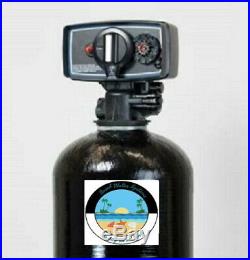

Whole House Fluoride & Chloramine, VOC’s, THM, H2S + Whole House Filter 2 cu ft Bone Char/Catalytic Carbon. Fleck 5600 Filter Backwash Valve. Whole House 2 Cubic Feet Blended Catalytic & Bone Char Carbon 1252 FRP Tank – Manual Backwash Valve. Unlike standard coconut or charcoal based carbon filters which cannot filter fluoride, our Whole House Filter uses a unique calcium based Bone Char carbon designed to reduce the fluoride from your water. Removes/Reduces Fluoride, and chemicals and odors. Additional Metals Addressed By Bone Char Carbon. The information provided on this table is based on Additional testing results of removal efficiency for heavy metals with the use of Bonechar courtesy of Glasgow University, UK and manufacturers of Bone Char. Additional contaminants that bone char carbon is recommended for are not certified by WQA or state standards. Contaminates addressed by bone char may not be in your water. The use of bone charcoal or bone char is reported to be an effective means for the reduction of fluoride. Bone charcoal contains a carbon structure while supporting a porous hydroxyapatite matrix (a calcium phosphate hydroxide in crystalline form which is rich in surface ions which can be readily replaced by fluoride ion). The carbon media also works like regular carbon does. A whole-house filter system treats all water traveling to any faucet or fixture in the home. It removes the chemical before it can be ingested, breathed in, or absorbed by the skin during washing or bathing. A larger carbon filter like this one provides better filtration because of the amount of carbon, and depth of the filter bed. It does not cause a water pressure drop in your home compared to solid block carbon filter installed at the point of entry. Carbon removes/reduces many volatile organic chemicals (VOC), pesticides and herbicides, as well as chlorine, benzene, trihalomethane (THM) compounds, radon, solvents and hundreds of other man-made chemicals found in tap water. Carbon is a substance that has a long history of being used to absorb impurities and is perhaps the most powerful absorbent known to man. One pound of carbon contains a surface area of roughly 125 acres and can absorb literally thousands of different chemicals. Activated carbon which has a slight electro-positive charge added to it, making it even more attractive to chemicals and impurities. Catalytic, high activity granular activated carbon manufactured by steam activation of select coconut shell charcoal. The catalytic activity of this activated carbon makes it highly effective for the removal of chloramines and hydrogen sulfide from potable water. Its large micropore volume makes it particularly well suited for the removal of low molecular weight organic compounds and their chlorinated by-products such as chloroform and other trihalomethanes (THMs). An important feature of this material is its superior mechanical hardness and the extensive dedusting during its manufacture ensures an exceptionally clean activated carbon product. 1 – 12X52 FRP vessel (Color Varies). 1 – Fleck 5600 Filter Backwash Valve. 2 – Cubic ft Blended Bone Char & Catalytic Carbon. 1 – 1 Bypass Valve. Used or installed items are not accepted for return. The item “Whole House Fluoride/Chloramine Reduction/Removal Bone Char Catalytic Carbon 2CF” is in sale since Tuesday, June 25, 2019. This item is in the category “Home & Garden\Kitchen, Dining & Bar\Small Kitchen Appliances\Water Purification\Water Filters”. The seller is “basedwatersystems” and is located in Lancaster, California. This item can be shipped to United States, Canada, United Kingdom, Denmark, Romania, Slovakia, Bulgaria, Czech republic, Finland, Hungary, Latvia, Lithuania, Malta, Estonia, Australia, Greece, Portugal, Cyprus, Slovenia, Japan, China, Sweden, South Korea, Indonesia, Taiwan, South africa, Thailand, Belgium, France, Hong Kong, Ireland, Netherlands, Poland, Spain, Italy, Germany, Austria, Bahamas, Israel, Mexico, New Zealand, Singapore, Switzerland, Norway, Saudi arabia, Ukraine, United arab emirates, Qatar, Kuwait, Bahrain, Croatia, Malaysia, Brazil, Chile, Colombia, Costa rica, Panama, Trinidad and tobago, Guatemala, Honduras, Jamaica, Barbados, Bangladesh, Bermuda, Brunei darussalam, Bolivia, Egypt, French guiana, Gibraltar, Guadeloupe, Iceland, Jordan, Cambodia, Cayman islands, Sri lanka, Luxembourg, Maldives, Nicaragua, Oman, Peru, Pakistan, Paraguay, Viet nam, Uruguay.
- Model: WHBCCAT
- Filtration Method: Carbon/Charcoal
- Number of Filtrations: 2
- Type: Water Filter
- Color: Multicolor
- MPN: TWPBBC1252
- Contaminant Removal: Flouride,Chloramine,Chlorine,VOC’s, H2S, Chemicals
- Brand: Titan
- Suitable For: Commercial
